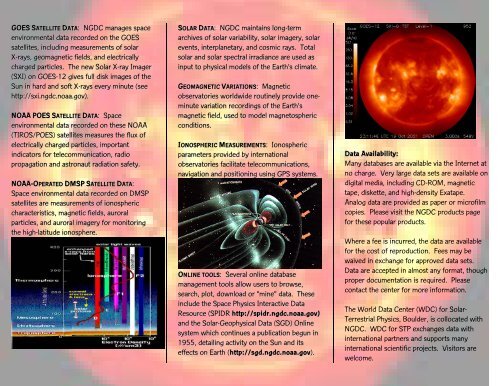Download brochure - nesdis - NOAA
Download brochure - nesdis - NOAA
Download brochure - nesdis - NOAA
You also want an ePaper? Increase the reach of your titles
YUMPU automatically turns print PDFs into web optimized ePapers that Google loves.
GOES SATELLITE DATA: NGDC manages space<br />
environmental data recorded on the GOES<br />
satellites, including measurements of solar<br />
X-rays, geomagnetic fields, and electrically<br />
charged particles. The new Solar X-ray Imager<br />
(SXI) on GOES-12 gives full disk images of the<br />
Sun in hard and soft X-rays every minute (see<br />
http://sxi.ngdc.noaa.gov).<br />
<strong>NOAA</strong> POES SATELLITE DATA: Space<br />
environmental data recorded on these <strong>NOAA</strong><br />
(TIROS/POES) satellites measures the flux of<br />
electrically charged particles, important<br />
indicators for telecommunication, radio<br />
propagation and astronaut radiation safety.<br />
<strong>NOAA</strong>-OPERATED DMSP SATELLITE DATA:<br />
Space environmental data recorded on DMSP<br />
satellites are measurements of ionospheric<br />
characteristics, magnetic fields, auroral<br />
particles, and auroral imagery for monitoring<br />
the high-latitude ionosphere.<br />
SOLAR DATA: NGDC maintains long-term<br />
archives of solar variability, solar imagery, solar<br />
events, interplanetary, and cosmic rays. Total<br />
solar and solar spectral irradiance are used as<br />
input to physical models of the Earth’s climate.<br />
GEOMAGNETIC VARIATIONS: Magnetic<br />
observatories worldwide routinely provide oneminute<br />
variation recordings of the Earth’s<br />
magnetic field, used to model magnetospheric<br />
conditions.<br />
IONOSPHERIC MEASUREMENTS: Ionospheric<br />
parameters provided by international<br />
observatories facilitate telecommunications,<br />
navigation and positioning using GPS systems.<br />
ONLINE TOOLS: Several online database<br />
management tools allow users to browse,<br />
search, plot, download or “mine” data. These<br />
include the Space Physics Interactive Data<br />
Resource (SPIDR http://spidr.ngdc.noaa.gov)<br />
and the Solar-Geophysical Data (SGD) Online<br />
system which continues a publication begun in<br />
1955, detailing activity on the Sun and its<br />
effects on Earth (http://sgd.ngdc.noaa.gov).<br />
Data Availability:<br />
Many databases are available via the Internet at<br />
no charge. Very large data sets are available on<br />
digital media, including CD-ROM, magnetic<br />
tape, diskette, and high-density Exatape.<br />
Analog data are provided as paper or microfilm<br />
copies. Please visit the NGDC products page<br />
for these popular products.<br />
Where a fee is incurred, the data are available<br />
for the cost of reproduction. Fees may be<br />
waived in exchange for approved data sets.<br />
Data are accepted in almost any format, though<br />
proper documentation is required. Please<br />
contact the center for more information.<br />
The World Data Center (WDC) for Solar-<br />
Terrestrial Physics, Boulder, is collocated with<br />
NGDC. WDC for STP exchanges data with<br />
international partners and supports many<br />
international scientific projects. Visitors are<br />
welcome.
The <strong>NOAA</strong> NGDC Space Weather Program<br />
supports the U.S. National Space Weather Program<br />
with solar and space environment data from global<br />
networks, by managing the national data archives,<br />
preparing useful products, and providing services<br />
for environmental data. NGDC researches the use<br />
of numerical models to assess and predict the<br />
space environment.<br />
GOES, POES (<strong>NOAA</strong> TIROS) and DMSP satellites<br />
observe and monitor the space environment.<br />
Ground-based programs provide solar, cosmic rays,<br />
ionospheric, and geomagnetic variations databases.<br />
Significant recent additions are GOES Solar X-Ray<br />
Images and solar radio spectral one-second burst<br />
data.<br />
Violent storms on the Sun emit large numbers of<br />
high energy particles that propagate to the Earth,<br />
affecting the local environment and disrupting<br />
operations of technology systems. Effects on the<br />
Earth’s environment include the aurora, solar<br />
proton events, geomagnetic storms, and<br />
ionospheric storms which disrupt communication<br />
and navigation systems.<br />
Geomagnetic storms and increased solar<br />
ultraviolet (UV) emissions heat the Earth’s upper<br />
atmosphere, causing it to expand and thereby<br />
increase the drag on satellites.<br />
Ionospheric data are used to drive space weather<br />
models that reduce errors in GPS positions. Space<br />
Weather “Climatology” as a gridded database gives<br />
an overview of the state of the near-Earth space<br />
environment.<br />
US Department of Commerce<br />
National Oceanic & Atmospheric Administration (<strong>NOAA</strong>)<br />
National Environmental Satellite, Data & Information Service<br />
National Geophysical Data Center<br />
David Skaggs Research Center, Boulder, Colorado, USA<br />
Mailing Address:<br />
National Geophysical Data Center<br />
325 Broadway, E/GC2<br />
Boulder, CO 80305-3328 USA<br />
Phone: 303-497-6826<br />
Fax: 303-497-6513<br />
TDD: 303-497-6958<br />
Email: ngdc.info@noaa.gov<br />
http://www.ngdc.noaa.gov/<br />
NGDC Online Store and products:<br />
http://www.ngdc.noaa.gov/products/<br />
Space Weather data ordering information:<br />
Phone: 303-497-6761<br />
Email: Craig.A.Clark@noaa.gov<br />
Space Weather technical contact:<br />
Phone: 303-497-6346<br />
Email: Eric.A.Kihn@noaa.gov<br />
http://spidr.ngdc.noaa.gov<br />
http://sgd.ngdc.noaa.gov<br />
http://sxi.ngdc.noaa.gov<br />
<strong>NOAA</strong> Satellites and Information<br />
http://www.<strong>nesdis</strong>.noaa.gov<br />
Space<br />
Weather Data<br />
available from the<br />
National Geophysical<br />
Data Center


